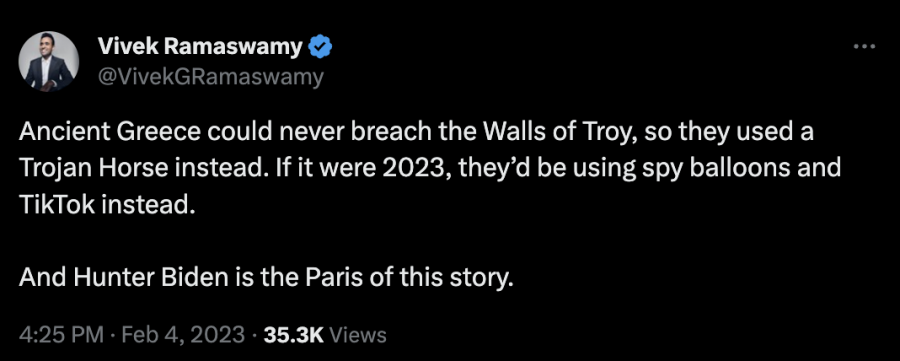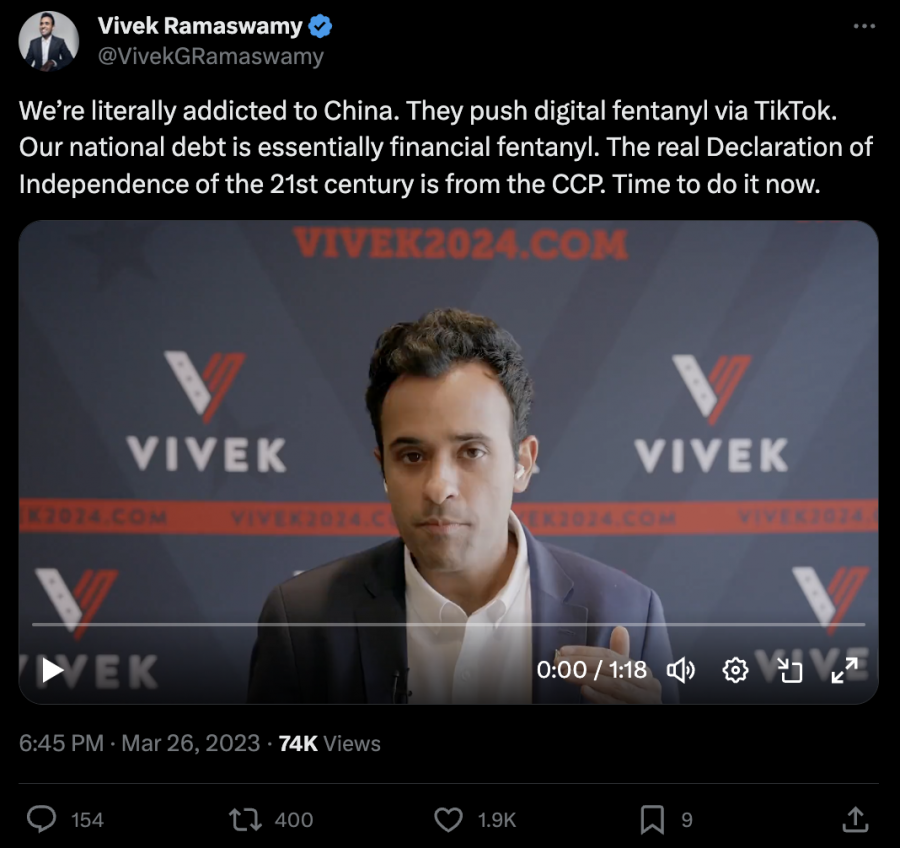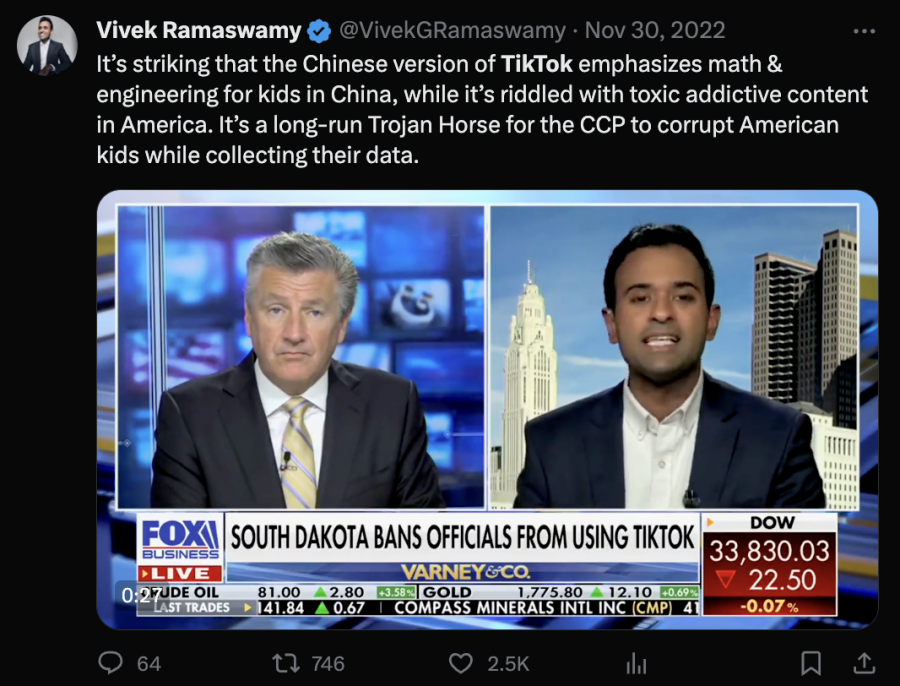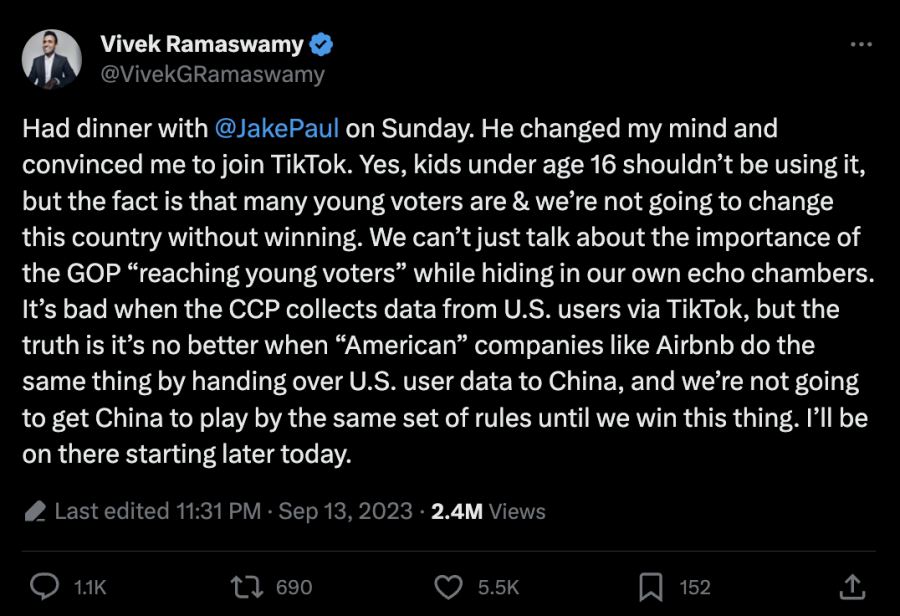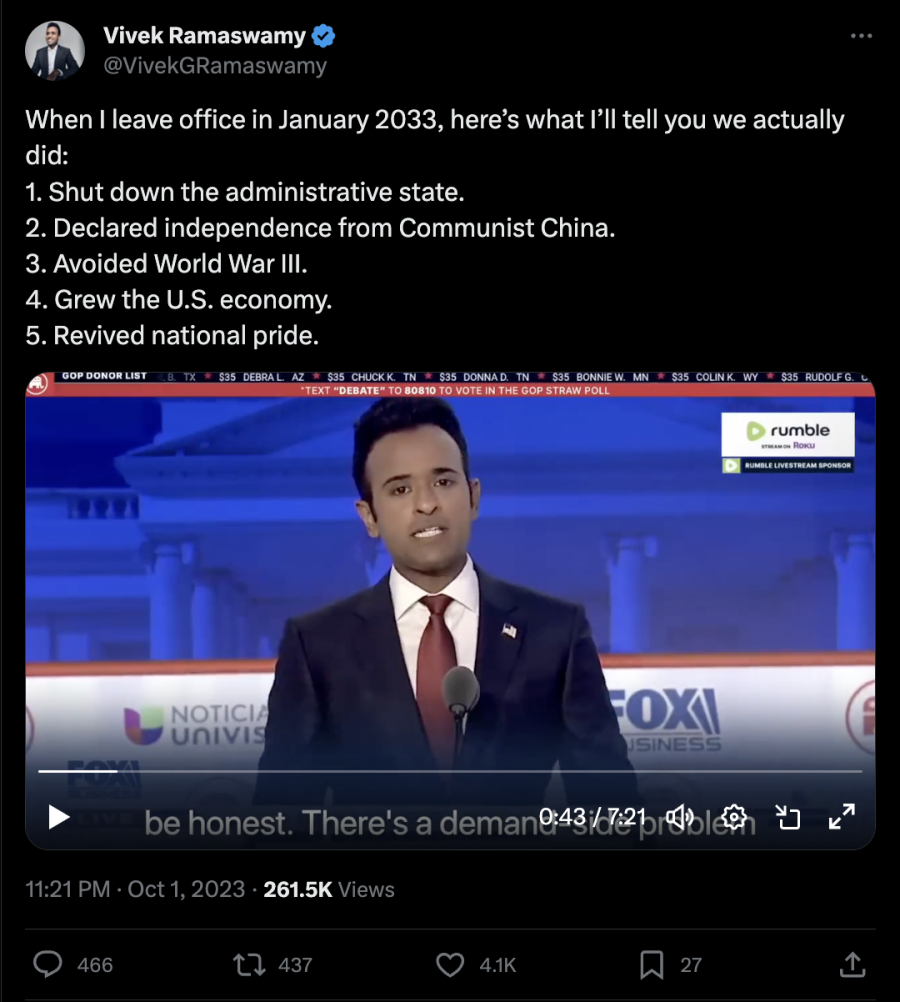
Trumper than Trump? Vivek Ramaswamy’s Anti-China Stance & populist rhetoric
In the current landscape of American politics, one undeniable common thread is the recurring anti-Chinese media discourse that appears to have secured a permanent seat in every political debate. This paper explores the TikTok ban, frequently a subject of discourse by US presidential candidate Vivek Ramaswamy, and how he shapes this prevailing narrative.
The outsider
Vivek Ramaswamy, a US presidential candidate from the Republican party, is outspoken about China on X, formerly known as Twitter. His 2024 presidential candidacy revolves prominently around his stance on China, particularly his views on TikTok, championing far-right ideas and foreign policies that advocate declaring independence from "Communist China" (Vivek 2024, 2023a). This stance has gained traction from right-wing individuals. Although he has no previous experience in politics, Ramaswamy holds a slight but stark resemblance to Trump concerning his anti-China stance and populist rhetoric.
Like Trump, Ramaswamy positions himself as an outsider who claims he can benefit US citizens if elected. Using emotionally charged language in debates and on social media, he employs a conservative, anti-China discourse resonating with both the conservative base and young voters. His ideology emphasises nationalism and scepticism toward Chinese influence on America. He presents himself as a businessman rather than a politician, which can appeal to voters seeking an alternative approach to leadership. Ramaswamy unequivocally expresses his perspectives on China, including TikTok and its data collection methods, actively contributing to the larger discourse critical of China. On numerous occasions, he has labelled the alleged Chinese-owned platform "digital fentanyl" and a "Trojan horse," only to eventually join it himself, displaying an ironic twist. This paper will focus on how Ramaswamy frames TikTok and attempts to win the 2024 elections by advocating an anti-Chinese discourse.
Decoding Discourse
CDA, Data, Ideology
I will perform a Critical Discourse Analysis (CDA) to dissect Ramaswamy's rhetoric. Dijk (2001) describes critical discourse analysis as an approach that centres its attention on social issues, particularly on how discourse plays a pivotal role in creating and perpetuating power imbalances and forms of domination. This approach will help uncover insights about how language is used to construct meaning, shape attitudes, and reflect societal dynamics. Selected tweets from his X account serve as evidence of Ramaswamy's strong anti-China stance concerning TikTok. Analysing this data will help us understand the discourse strategies he employs to convey his ideas and beliefs. Moreover, it will give insight into how he frames his anti-China discourse and how it may persuade or influence others, thus contributing to the existing anti-China discourse in the US.
To examine the language and anti-China stance evident in his political discourse, the data will be sourced from his X account, his campaign website, and a TikTok video where he justifies his platform choice. Uptakes on a few of his tweets will also be analysed for further understanding. Examining uptakes is crucial as it will provide insights into how the audience perceives and responds to communicated information, offering valuable data for assessing the effectiveness and credibility of Ramaswamy's discourse.
To analyse Ramaswamy's language and messaging, I will use the concept of intertextuality. According to Blommaert (2020), intertextuality refers to the creation of meaning that is inherently linked to previous texts, discourses, and contexts. This will help us understand the meaning-making in the language Ramaswamy uses in the context of TikTok and shed light on the ideological dimensions of his discourse.
Additionally the concepts of ideology and hegemony will be applied to understand how Ramaswamy directs this power discourse to influence public opinion. Ideology, as explained by Verschueren (2011) is not just a set of beliefs, ideas, or opinions but rather pieces of discourse that have underlying patterns of meanings or frames of interpretation. Ideology, therefore, helps shape the values and norms of individuals and societies, further legitimising the power structures and hierarchies that align with it.
The concept of ideology is closely interlinked with hegemony. Antonio Gramsci theorised hegemony as the dominance of a particular group or class through not just coercion but also consent (Blommaert et al., 2003). To understand power in politics, it is important to grasp the concepts of ideology and hegemony. Ideologies help sustain power structures and social norms, therefore serving as a key tool to establish and maintain hegemony (Verschueren, 2011). Lastly, I will build on Antonio Gramsci’s notion of a dual perspective. Gramsci draws on elements from Niccolò Machiavelli's metaphor, the Centaur, half-animal half-human, to understand the various levels of power dynamics and strategies in politics. These levels reflect the Centaur’s inherent duality of force and consent, authority and hegemony, violence and civilisation, of the individual moment and of the universal moment (“Church” and “State”), of agitation and of propaganda, of tactics and of strategy (Bairner, 1981). The notion of dual perspective provides a theoretical framework to analyse the complexities within Ramaswamy's discourse, particularly in understanding how he navigates and employs these dualities to align with his political ambitions.
Drawing upon these concepts, this research attempts to answer the question: How does Vivek Ramaswamy's dual-perspective strategy promote a hegemonic narrative of anti-China discourse in U.S. politics, particularly in the context of his potential presidential actions?
Crafting persuasion: A populist's approach
The anti-China discourse has prominently shaped US-China relations. Over the years, the Chinese Communist Party (CCP) has consistently been perceived as a growing threat to American democratic governance and security. The COVID-19 pandemic further intensified the anti-China discourse within U.S. policymaking circles, reshaping perspectives and approaches (Narayanan, 2021). The widespread nature of anti-China sentiment varies across different layers of the U.S. population and it also resonates in public discourse, influenced by media narratives and political rhetoric.
Within the context of his election campaign, Ramaswamy consistently centres his discourse on China. This analysis delves deeper into how he puts forth his nationalist ideology, rhetorical strategies, and messaging tactics. His tweets and interviews consistently express anti-Chinese sentiments and policies. He mainly reposts his interviews on X along with his policies, so only a few of his tweets will be analysed through a critical discourse approach.
Figure 1: Tweet drawing parallels between Trojan horse and China
In the above tweet (Figure 1), Ramaswamy calls TikTok China’s Trojan horse. Analyzing the tweet in the context of intertextuality, Ramaswamy characterises TikTok as China's Trojan horse, employing a metaphorical analogy that draws on the ancient Greek tale found in Homer's Iliad. The Greeks invaded and conquered the city of Troy by gifting the Trojans a large wooden horse that hid around 40 warriors. The war, however, was caused by Paris, the son of the Trojan King. Unlike the mythological narrative, the tweet introduces a modern scenario involving spy balloons and TikTok, with Hunter Biden serving as a contemporary point of reference. The reference to the 2023 incident where the US allegedly shot down a Chinese spy balloon adds a contextual layer. The tweet suggests a hypothetical situation in 2023 wherein the Greeks, would employ methods such as spy balloons and TikTok for infiltration, drawing a connection to China's action. The explicit mention of TikTok directly taps into the ongoing debate surrounding its use, ban, and associated concerns about data collection within the US.
Furthermore, his analogy between the Trojan horse and the current political scenario in the US enhances the tweet’s communicative power. It rhetorically hints at a stance that is cautious of the Chinese government and the potential use of TikTok for strategic purposes. This caution extends to broader discussions surrounding the platform's influence and data-related controversies, as elaborated in subsequent tweets.
Figure 2: Ramaswamy calls TikTok Digital Fentanyl
Ramaswamy has referred to TikTok as digital fentanyl on several occasions and called for a declaration of independence from the Chinese Communist Party (CCP). If we look at this tweet (Figure 2) through Gramsci’s dual perspective, it employs a clear set of tactics and strategies to advocate broader anti-Chinese propaganda. By saying that we are addicted to China, Ramaswamy exaggerates the extent of the US's dependence on China. The terms “Digital fentanyl” & “Financial fentanyl” are used as metaphorical expressions denoting the highly addictive and dangerous opioid fentanyl. Fentanyl, a potent and dangerous drug, is widely recognised as a significant problem in the United States (Sullivan, 2023). Ramaswamy hopes to leverage this shared consensus about the real drug problem and applies it metaphorically to different contexts. Here, he implies that TikTok is highly addictive and promotes harmful digital content or behaviour.
It also conveys how China’s digital and cultural influence is pervasive leading to a perceived cultural hegemony, thereby suggesting the need for a “declaration of Independence.” Through this, Ramaswamy constructs a narrative where China is framed as a powerful force looking to control the US. He concludes the tweet with a call for action, urging individuals to take action against the supposed influence of the CCP. This aligns strategically with the prevalent anti-China discourse, effectively gaining momentum. He seeks to mobilise public sentiment against China by framing its influence as a pressing issue and calling for decisive action. It reinforces an anti-China discourse by portraying China as a source of negative influence and positioning the CCP as a force against which independence is sought.
Figure 3: Ramaswamy's calls out TikTok for its toxic and addictive content
The above tweet (Figure 3) employs a comparative approach, contrasting the Chinese and American versions of TikTok. By portraying the Chinese version of TikTok as promoting education while characterising the American version as having "toxic addictive content," it establishes a contrast that potentially reinforces negative stereotypes about China. Additionally, the reference to the CCP as orchestrating a "Trojan Horse" frames TikTok as a deceptive tool that corrupts American youth and collects their data, further perpetuating a narrative of suspicion and antagonism. Ramaswamy’s communication attempts to frame these concerns in a seemingly logical manner that resonates with the popular anti-Chinese sentiment in the US. In this way, the tweet seeks to make these views more widely accepted, thereby normalising a particular anti-Chinese ideology (Maly, 2022). Overall, these rhetorical tactics work to promote an unfavourable view of China and the CCP's influence on American youth, fitting into the broader anti-Chinese narrative.
This framing of TikTok obfuscates the web 2.0 nature of TikTok. TikTok here is not understood as a socio-technical assemblage (Bucher, 2018) but in terms of older, more hierarchically programmed media. In reality, it is not TikTok that produces content, it is American users. If we understand that algorithms are not just technical programs, but exist concerning human data, it becomes clear that they make visible content that users find engaging. The difference in content between the 'Chinese TikTok' and the 'American TikTok', is thus not purely technical, but the result of 'interaction of American users' with the platform affordances and algorithms. This complexity of digital media is replaced by an image where TikTok is programmed top-down to destroy America. This discourse is mobilised to normalise an anti-China stance.
From critic to user
Figure 4: Ramaswamy joins TikTok
Ramaswamy's discourse reveals a strategic evolution in his stance on TikTok, initially labelling it as "digital fentanyl" and a "Trojan horse" for the CCP, only to subsequently join the platform. On September 13th, he joined TikTok and announced it in the above tweet (Figure 4). He wrote about how Jake Paul. a popular YouTuber, boxer, and creator, convinced him to join TikTok. The association with Jake Paul adds a layer of controversy to Ramaswamy's narrative, given Paul's polarising reputation within online communities.
In his tweet, Ramaswamy emphasises the importance of young voters in the political landscape and suggests that the Grand Old Party (GOP) should engage with this demographic. While he mentions the Chinese government's data collection practices through TikTok, he also criticises "American" companies like Airbnb for similar data practices, indicating a broader concern about data privacy. However, his concerns about data privacy reflect a stance critical of Chinese data practices - it is seemingly only a problem when those American firms hand over the data to the Chinese government, not if they give it to the US. Underneath his anti-TikTok discourse is an anti-China discourse. And of course, he emphasises that change can only be brought about if they win the election.
His intentions to join the app also signal a willingness to adapt to new platforms and an understanding of the importance of reaching young voters where they are active. There is a noticeable change in his communication, shifting from initially criticising the platform to now using it as a means to engage with young voters. However, his justification for joining the platform comes across as a calculated move to conceal his changing stance and hypocrisy. His apparent contradiction invites scrutiny into whether Ramaswamy uses the discourse around data privacy and criticism of American companies as a smokescreen for political advantage on the TikTok platform. The shift in his stance highlights his adaptability and strategic approach to reaching his target audience for votes.
In his first TikTok video, he mentions that the current generation of politicians is disconnected from contemporary societal realities (Ramaswamy, n.d.) and that it would take an outsider like him to bring about change. He goes on to state how he cares about the issues that affect not just millennials but also Gen Z and all young people. Ergo, his flip-flopping is framed as 'necessary for his young voters'. Furthermore, Ramaswamy has previously called for a proposal for raising the voting age from 18 to 25. This appears contradictory because while Ramaswamy claims to care about the concerns of both millennials and Gen Z, his proposal to raise the voting age to 25 implies a limitation on the political participation of these very groups.
In a GOP presidential primary debate held on 9th November, an NBC moderator asked Ramaswamy how he aims to ban TikTok if he uses it (NBC News, 2023). His response to that question reveals a strategic use of discourse. Firstly, he deflected criticism towards Nikki Haley by asserting the need for her to address her daughter's TikTok usage rather than directly addressing the critique aimed at him. This strategic maneuver effectively steered the conversation away from his actions, allowing him to avoid direct scrutiny. Then, he legitimised his presence on the app by arguing that it serves as a means to engage with young voters while simultaneously advocating for a broader ban on any US companies transferring data to China.
Ramaswamy defines America First 2.0 as an extension of the original America First agenda, aiming to go beyond Donald Trump's approach. His vision seeks to revive the national identity, foster self-confidence for economic growth, assert independence from China unapologetically, and address the rise of the managerial bureaucracy, including dismantling the administrative state (Vivek 2024, 2023b). A steadfast advocate of nationalist ideology, Ramaswamy consistently shapes America First 2.0 through a resolute anti-China stance in his discourse.
His discourse often raises questions about the consistency of his stance regarding youth engagement in politics and his understanding of government functionality, leaving him vulnerable to criticism from rivals.
Uptakes
Despite facing harsh criticism, it is reasonable to argue that Ramaswamy utilises the platform's discursive power to shape conversations, promote his beliefs, and gain support for his political goals. This demonstrates that he understands how digital media not only convey information but also govern how people can interact with one another (Maly, 2023). However, the efficacy of his discourse is not uniform, evidenced by diverse reactions that include calls for accountability due to perceived inconsistency and hypocrisy. Examining various responses and criticisms will provide a nuanced perspective on the impact of his rhetorical strategies.
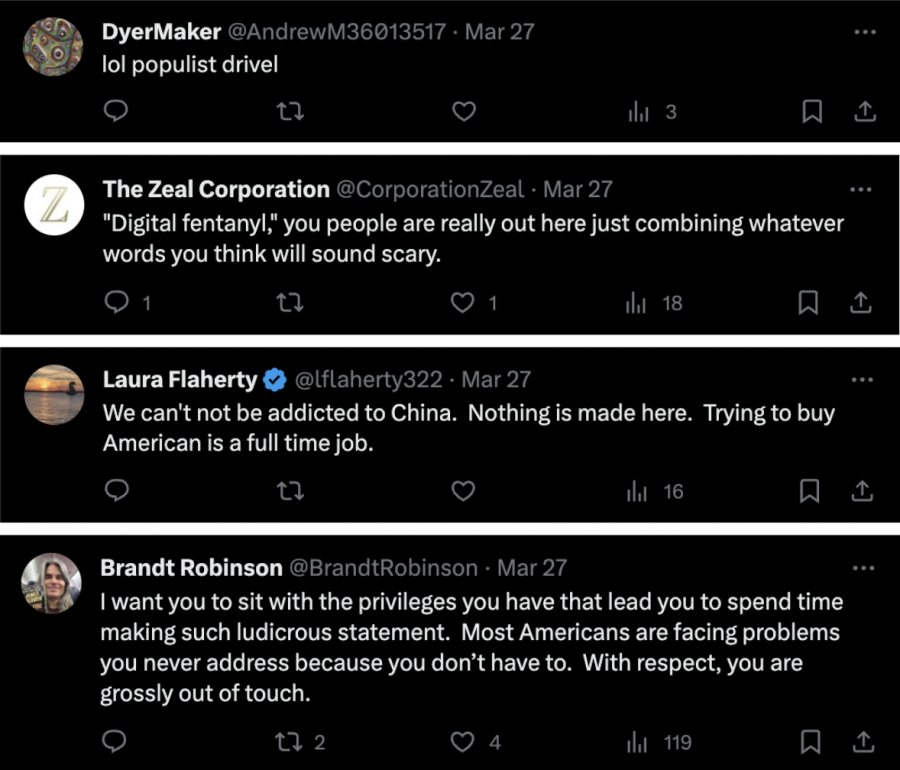 © AndrewM36013517 @CorporationZeal @lflaherty322 @BrandtRobinson
© AndrewM36013517 @CorporationZeal @lflaherty322 @BrandtRobinsonFigure 5: Criticism from X users regarding Ramaswamy's reference to TikTok as "digital fentanyl."

Figure 5: Criticism from X users regarding Ramaswamy's reference to TikTok as "digital fentanyl."
While Ramaswamy's tweets receive a lot of traction, they have also generated diverse uptakes (Figure 5). One user dismisses Ramaswamy's tweet as a populist drivel, implying it lacks substantive analysis and relies on emotional appeal. Another criticises the use of "digital fentanyl" as a scare tactic, highlighting perceived sensationalism. A more nuanced perspective in the third response acknowledges the complexity of reducing dependence on China, considering extensive manufacturing and trade relationships. However, the fourth response draws attention to Ramaswamy's privilege, suggesting a potential lack of understanding of the challenges faced by many Americans, and questioning the relevance of his concerns. This critique implies that Ramaswamy's discourse may lack depth and fail to engage with the intricate realities of his audience. The specific terms used, such as "fentanyl," appear to fall short of achieving the intended impact, contributing to perceptions of superficiality. The replies collectively convey a perception that his discourse lacks depth, potentially relies on sensationalism, and exhibits a detachment from the lived experiences of a considerable audience, thereby diminishing its effectiveness and credibility.
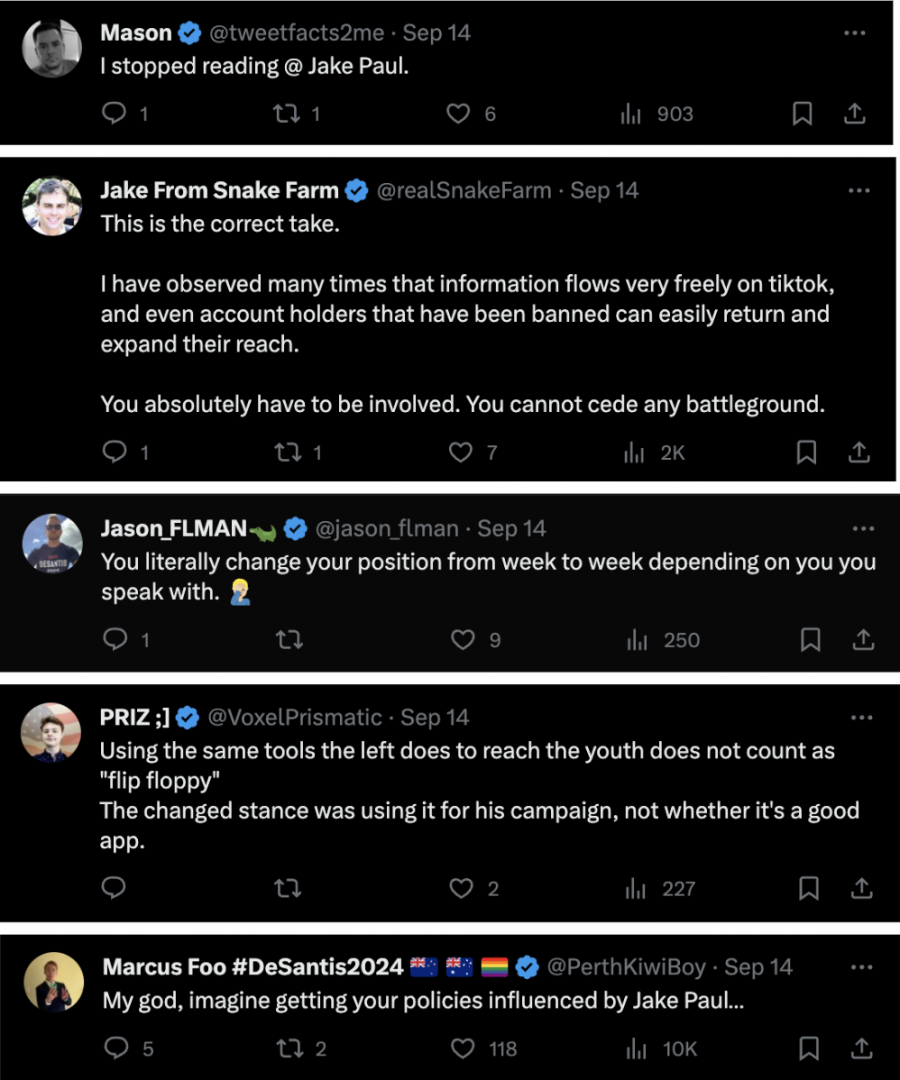
Figure 6: users react to Ramaswamy TikTok debut influenced by Jake paul
Following Ramaswamy’s announcement of joining TikTok, users responded with a mix of criticism and sarcasm (Figure 6). Some immediately dismissed the decision upon seeing Jake Paul's involvement, expressing scepticism about Paul's credibility and potential influence on political policies. Conversely, others supported Ramaswamy's perspective, emphasising TikTok's significance in reaching young voters. Criticisms of perceived inconsistency in Ramaswamy's positions also surfaced, raising concerns about the reliability of his discourse. The choice of Jake Paul as an influencer and the platform collectively contribute to an interpretation of his discourse as somewhat uncertain or wavering in its messaging and strategic direction.
Ramaswamy’s blueprint: Right leanings, anti-China stance and victory
Ramaswamy consistently promotes a nationalist ideology, envisioning an America 2.0, despite his apparent inconsistency, such as advocating for a TikTok ban before subsequently joining the platform. On his campaign website, a section titled “TRUTH” contains statements such as “God is real,” “There are two genders,” “Reverse racism is racism,” and “An open border is no border.” These statements revolve around multifaceted topics. It might be that he simplifies complex issues in the context of his election campaign. They convey a strong conservative view on various topics, including religion, gender, racial issues, border security, and government. However, collectively, they indicate an ideological inclination toward the right wing. His stance on China is characterised by an anti-China ideology, aligning with a right-wing perspective. This is evident in his advocacy for issues such as a TikTok ban and an emphasis on border security, reflecting a position that opposes or challenges Chinese influence and practices. While he critiques TikTok, attributing it to concerns such as data privacy and cultural influence, it encompasses an underlying anti-China discourse.
Figure 7: Ramaswamy's Post-Victory Commitments
From the beginning, Ramaswamy has been very clear about his goals upon winning the election and often posts them on his X account, while also talking about them in his interviews. In the above tweet (Figure 7), Ramaswamy uses several discursive strategies to convey a set of five accomplishments and ambitious goals he will have achieved by the time his tenure is done. He sets future expectations by listing down these five clear narratives by projecting into the future, aiming to shape a positive legacy. His tweet implies a desire for greater autonomy. “Avoided World War 3” statement positions him as a leader who prevented a global conflict and maintained peace. Additionally, the reference to reviving national pride invokes a sense of collective belonging and attachment to one's country.
The aspirational language he uses to create America 2.0, can resonate with those who share similar goals, potentially garnering support. He does not go into the specifics of the strategy implementation, allowing him to possibly appeal to a broader audience. Overall, he employs rhetoric and messaging techniques to persuade the audience while creating a positive narrative about his potential leadership. Ramaswamy frequently presents his policies on X and in debates. However, there is a pattern in the way he communicates his nationalist ideology to garner support. He consistently articulates his radical goals regarding his potential victory with conviction, thus, setting expectations and positioning himself as a leader who envisions a better future, or rather, America 2.0. And, evidently, he strategically relies on an anti-China discourse as a focal point of his messaging.
Ramaswamy's discourse operates as an indexical marker for larger ideological currents that shape the anti-China discourse in the US. The alignment of his views with conservative and nationalist perspectives suggests a connection between his ideological stance and the prevalent sentiment against China. This connection implies that his discourse is not solely an individual expression but rather reflective of larger ideological currents that shape the anti-China discourse in the US.
Hegemonic position within the US
China’s form of governance is different from some Western countries. While the US and other Western liberal democracies have advocated neoliberalism, emphasising free markets, free trade, and limited government intervention, China's authoritative system has emerged as an economic and political force without adhering to a liberal narrative. Furthermore, the anti-China discourse in the US is fuelled by years of geopolitical tensions between the two superpowers (Greenwood, 2023). This discourse is further strengthened by the contrasting ideologies between the 'free West' with the 'communist' system in China. Americans, particularly within the Republican demographic perceive China as a significant threat to both the economic well-being and national security of the United States (Pew Research Center, 2023). This sentiment is echoed by key GOP figures such as Nikki Haley, who characterises 'Communist China' as an enemy preparing for war, Trump's 2024 campaign focusing on reclaiming economic independence from China, Ron DeSantis pledging to revoke China's trade status if elected president, Mike Pence identifying China as the "greatest economic and strategic threat" in the 21st century, and Doug Burgum framing US-China tensions as a Cold War scenario (Yilek, 2023). Undoubtedly, the GOP candidates consistently portray China as an adversary, particularly concerning economic and financial matters. This alignment with the prevailing anti-China sentiment solidifies its hegemonic influence. The anti-China discourse in the US sets the stage for understanding the broader context in which political figures like Ramaswamy operate. The sentiments against China, as articulated by the GOP candidates, create a fertile ground for political narratives that challenge China's influence.
The analysis of Ramaswamy's discourse highlights two key aspects. First, his rhetoric significantly contributes to the larger discourse opposing China, a prevalent theme in contemporary political discussions in the US. Second, by consistently framing messages that challenge China's influence, he positions himself as a defender of national pride and peace while attempting to resonate with the sentiments of a substantial portion of the population. Moreover, Ramaswamy's ambition to push America into a “2.0” era by employing diverse methods, including independence from China, demonstrates his utilisation of strategy and tactics. His communication not only reinforces the existing anti-China discourse but also actively participates in constructing a hegemonic position within US politics.
As an outsider, Ramaswamy claims he can bring about a transformation. Ramaswamy strategically garners support by discussing his anti-China policies and presenting them as the means to bring about positive change, framing his potential election as the necessary step to achieve these improvements. This approach also aligns with the core principles of Gramsci's notion of dual perspective, where political actors simultaneously engage with established power structures while challenging them.
And, in a striking twist, Ramaswamy’s audacious quest for America “2.0” shares intriguing parallels with the sentiments echoed in Trump's 'Make America Great Again' (MAGA) movement, a topic that deserves another critical discourse paper.
References
Bairner, A. E. S., & University of Hull. (1981). The dual perspective : an examination of the origins, development and theoretical significance of antonio gramsci's theory of the state (dissertation). University of Hull.
Blommaert, J., Collins, J., Heller, M., & Verschueren, J. (2003). Ethnographies of hegemony: Introduction. ResearchGate.
Blommaert, J. (2020). Jan Blommaert on intertextuality. YouTube.
Bucher, T. (2018). If. . .Then. In Oxford University Press eBooks.
Dijk, T. (2001). Multidisciplinary cda: a plea for diversity. In Methods of Critical Discourse Analysis (pp. 95-120). SAGE Publications Ltd.
Greenwood, S. (2023). Global public opinion of China during the XI Era | Pew Research Center. Pew Research Center’s Global Attitudes Project.
Maly, I. (2022). From methodology to method and back. Some notes on digital discourse analysis. Diggit Magazine.
Maly, I. (2023). Digital economy and platform ideologies. Diggit Magazine.
Narayanan, S. (2021). "Knowing China, Losing China: Discourse and Power in U.S.-China Relations". University Scholar Projects. 70.
NBC News. (2023). WATCH: Haley and Ramaswamy spar over TikTok ban and China relations [Video].
Pew Research Center. (2023). Americans name China as the country posing the greatest threat to the U.S. | Pew Research Center.
Ramaswamy, V. (n.d.). I’m the 2024 presidential candidate. [Video]. TikTok.
Sullivan, K. (2023). Fentanyl plus stimulants drives ‘fourth wave’ of overdose epidemic in the U.S. NBC News.
Verschueren, J. (2011). Ideology in Language Use: Pragmatic Guidelines for Empirical Research. Cambridge: Cambridge University Press.
Vivek 2024. (2023a). Declare Independence from Communist China - Vivek 2024.
Vivek 2024. (2023b). America First 2.0 - Vivek 2024.
Yilek, C. (2023). Where the 2024 Republican presidential candidates stand on China. CBS News.
